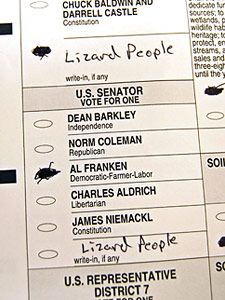 I found this document from the Secretary of State’s office that, I believe, is meant to be a guide for election officials. The language is a little more plain than the state’s voter intent statute.
I found this document from the Secretary of State’s office that, I believe, is meant to be a guide for election officials. The language is a little more plain than the state’s voter intent statute.
Here’s the key sentence that solves our Lizard People ballot question:
Count all printed names with a mark made opposite them and all names written-in, not exceeding the number to be elected for that office.
Since you can only elect one person to the the U.S. Senate seat, the Lizard People ballot is an overvote. It doesn’t count, and neither does the “Bachmen” ballot.
The document includes a “Notes and Decisions” section that you might find relevant, if you’ve been following along with our discussions and the ballot judging game. The names in parentheses refer to the names we gave the ballots on the challenged ballots game.
Appearance of marks which trial court may reasonably consider to be tentative or accidental should not destroy ballot. (See: The Arrow, The Thumbprint, The Oops, The Dot, The Confusion) If the voter used an identifying mark or mark with the intent to identify the ballot, the entire ballot is defective. (See: The Signature)
Ballot containing oval mark in upper left hand corner, obviously made by voter in testing writing quality of pen before marking ballot, was properly counted despite claim that oval was an identifying mark. (See:The Autograph, maybe) Ballots which had crossmarks both in pencil and in ink on same ballot were properly counted. (See: The Pencil) Ballot which contained word “no” and an obliteration before name of one candidate was properly accepted for counting. (See: The NO ballot)
